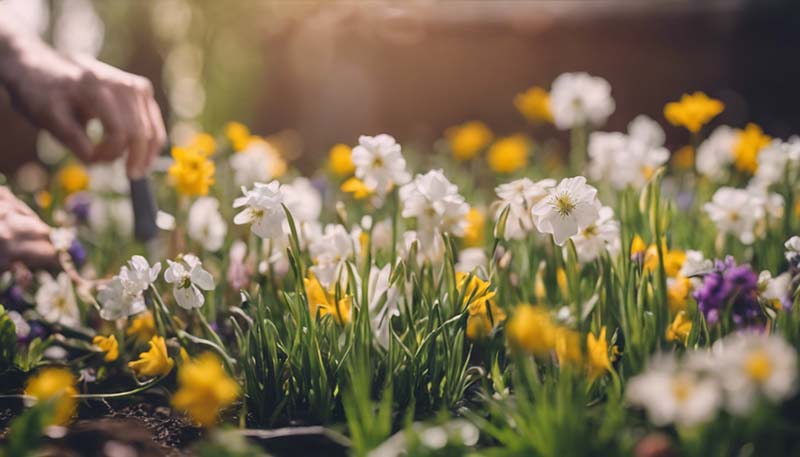Spring into Action: Preparing Your Garden for Seasonal Flowers
Maintenance | 2024-02-28
Spring into Action: Preparing Your Garden for Seasonal Flowers
As the snow melts and the days grow warmer, it's time to shake off the winter chill and turn your attention to your garden. Spring is the perfect season to start planning and preparing for a vibrant and colorful display of seasonal flowers. In this comprehensive guide, we'll walk you through the essential steps to get your garden ready for a spectacular show of blossoms.
1. Assess Your Garden's Conditions
Before you start planting, take a moment to evaluate your garden's current state. Consider the following factors:
- Sunlight: How much sun does your garden receive each day? Different flowers have different sunlight requirements.
- Soil: Is your soil well-draining? What is the pH level? You may need to amend your soil to create the ideal conditions for your flowers.
- Space: What is the size of your garden? This will determine how many plants you can accommodate and the types of arrangements you can create.
- Hardiness Zone: Knowing your hardiness zone is crucial for selecting flowers that can survive and thrive in your area.
2. Plan Your Garden Design
A well-thought-out design can make your garden more enjoyable and aesthetically pleasing. Here are some tips for planning your garden design:
Advertisement
- Choose a Theme: Decide on a color scheme or style that you want to achieve, such as a cottage garden, a tropical paradise, or a minimalist Zen garden.
- Layering: Use plants of varying heights to create depth and visual interest. This will also allow you to make the most of your space.
- Companion Planting: Some plants grow better when planted near others. Research companion plants to enhance growth and deter pests.
- Flow and Function: Plan for pathways and seating areas, ensuring that your garden is not only beautiful but also functional.
3. Prepare the Soil
Healthy soil is the foundation of a successful garden. Follow these steps to prepare your soil for planting:
- Clear Debris: Remove any leaves, weeds, or other debris from your garden beds.
- Till the Soil: Use a spade or tiller to loosen the soil to a depth of at least 12 inches, allowing air and nutrients to penetrate deeper.
- Add Organic Matter: Incorporate compost, aged manure, or other organic materials to improve soil structure and fertility.
- Test and Amend: Test your soil's pH and nutrient levels, and amend as necessary with lime, sulfur, or fertilizers.
4. Choose Your Flowers
Selecting the right flowers is key to a successful garden. Consider the following when choosing your plants:
- Climate: Choose flowers that are suited to your local climate and hardiness zone.
- Seasonal Interest: Select a mix of plants that bloom at different times throughout the growing season to maintain interest in your garden.
- Maintenance: Consider your available time and energy when choosing plants. Some flowers require more care than others.
- Attract Pollinators: Opt for flowers that attract bees, butterflies, and other pollinators to support local ecosystems.
5. Plant Your Flowers
Once your soil is prepared and your plants are selected, it's time to start planting. Here are some planting guidelines:
- Right Plant, Right Place: Ensure that each plant has the appropriate amount of sunlight and space to grow.
- Plant at the Right Time: Some flowers need to be planted in early spring, while others do better when planted later in the season.
- Water Wisely: Water your plants thoroughly after planting, and continue to water regularly, especially during dry spells.
- Mulch: Apply a layer of mulch around your plants to help retain moisture, suppress weeds, and regulate soil temperature.
6. Ongoing Garden Care
A beautiful garden requires regular care and maintenance. Here are some tips for ongoing garden care:

- Watering: Monitor your plants' water needs and adjust your watering schedule as needed.
- Fertilizing: Feed your plants with the appropriate type and amount of fertilizer to support healthy growth.
- Pruning: Prune as needed to remove dead or diseased growth and to encourage flowering.
- Pest and Disease Control: Keep an eye out for pests and diseases, and take action to control them using organic or chemical controls as needed.
7. Enjoy Your Garden
As your flowers begin to bloom, take the time to enjoy your garden. Here are some ways to make the most of your outdoor space:
- Outdoor Seating: Arrange comfortable seating to enjoy your garden's beauty.
- Garden Pathways: Create winding pathways to guide you through your garden and highlight different areas.
- Container Gardening: Use pots and planters to add additional flowers and greenery to your garden.
- Garden Art: Add sculptures, bird baths, or other decorative elements to personalize your space.
Conclusion
Preparing your garden for seasonal flowers is a rewarding process that can bring joy and beauty to your outdoor space. By assessing your garden's conditions, planning a thoughtful design, preparing the soil, choosing the right flowers, and providing ongoing care, you can create a garden that flourishes with color and life throughout the spring and summer months. So, grab your gloves, spade, and a sense of adventure, and spring into action to make your garden bloom.
Comments